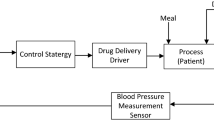Abstract
Purpose
Blood pressure of postoperative patient, especially adult cardiac patient, increases due to hypertension which can be lowered by injecting an anti-hypertension vasodilator drug sodium nitroprusside (SNP). Monitor and control of dose of drug infusion on patient is necessary to reduce the blood pressure to a prescribed level, which is an important issue in biomedical engineering drug delivery problems. So, there is a need of advanced control system which improves the health of patient in less time and also reduces clinical expenses.
Methods
In literature, patient’s response to the infusion of drug (SNP model) is modelled. This model has five parameters that vary from patient to patient depending upon his sensitivity to drug. The main objective of our proposed work is to design a robust controller based on internal model control (IMC) structure that works effectively with different types of patient. Here, IMC based one-degree-of-freedom proportional integral (ODF-PI) and two-degree-of-freedom proportional integral derivative (TDF-PID) controllers are designed by utilizing the optimal value of SNP model gain k. Unlike the conventional PI/PID controllers, IMC based PI/PID controller has only one tuning parameter λ which is tuned on the basis of the maximum sensitivity M S .
Results
The resulting controllers achieve better robust performance criteria for nominal as well as sensitive and insensitive patients.
Conclusions
The proposed technique is stable, accurate and applicable to a wide range of physiological variations in patient parameters.
Similar content being viewed by others
References
Behbehani K, Cross RR. A controller for regulation of mean arterial blood pressure using optimum nitroprusside infusion rate. IEEE T Bio-med Eng. 1991; 38:513–521.
Frei C, Derighetti M, Morari M, Glattfelder A, Zbinden A. Improved regulation of mean arterial blood pressure during anesthesia through estimates of surgery effects. IEEE T Biomed Eng. 2000; 47:1456–1464.
Bajzer Ž, Maruši M, Vuk-Pavlovi S. Conceptual frameworks for mathematical modelling of tumor growth dynamics. Math Comput Model. 1996; 23:31–46.
Bergman R, Phillips L, Cobelli C. Physiologic evaluation of factors controlling glucose tolerance in man. J Clin Invest 1981; 68:1456–1467.
Jeffrey AM., Xiaohua X, Craig IK. When to initiate HIV therapy: a control theoretic approach. IEEE T Bio-med Eng. 2003; 50:1213–1220.
Hernandez L, Shankar R, Pajunen G. A microprocessor based drug infusion control system employing a model reference adaptive control algorithm to regulate blood pressure in I.C.U. patients. Proc IEEE Southeastcon. 1989; 1261–1266.
Reves JG, Sheppard LC, Wallach R, Lell WA. Therapeutic uses of Sodium Nitroprusside and an automated method of administration. Int Anesthesiol Clin. 1978; 16:51–88.
Kovio AJ, Smollen VF, Barile RV. An automated drug administration system to control blood pressure in rabbits. Math Biosci. 1978; 38–45.
Sheppard LC, Shotts JF, Robertson NF, Wallace FD, Kouchoukos NT. Computer controlled infusion of vasoactive drugs in post cardiac surgical patients. Conf Proc IEEE Eng Med Biol Soc. 1979; 280–284.
Slate JB, Sheppard LC, Rideout VC, Blackstone EH. A model for design of a blood pressure controller for hypertensive patients. Proc IEEE EMBS Conf. 1979; 867–872.
Slate JB, Sheppard LC. A model-based adaptive blood pressure controller. Proceedings of IFAC Symposium on Identification and System Parameter Estimation, Washington DC. 1982. 1982; 1437–1442.
Martin JF, Schneider AM, Smith NT. Multiple-model adaptive control of blood pressure using sodium nitroprusside. IEEE T Bio-med Eng. 1987; BME-34:603–611.
Kaufman H, Roy R, Xu X. Model reference adaptive control of drug infusion rate. Automatica. 1984; 20:205–209.
Arnsparger JM. Adaptive control of blood pressure. IEEE T Bio-med Eng. 1983; BME-30:168–176.
Hahn J, Edison T, Edgar TF. Adaptive IMC control for drug infusion for biological systems. Control Eng Pract. 2002; 10:45–56.
Enbiya E, Hossain E, Mahieddine F. Performance of optimal IMC and PID Controllers for blood pressure control. IFMBE Proc. 2009; 24:89–94.
Morari M, Zafiriou E. Robust Process Control. Englewood Cliffs, NJ: Prentice-Hall; 1989.
Bequette BW. Process Control: Modeling, Design, and Simulation. Prentice-Hall, Inc., Upper Saddle River, New Jersey, USA; 2003.
Brosilow C, Joseph B. Techniques of Model-Based Control. Englewood Cliffs, NJ: Prentice-Hall; 2002.
Zhao Z, Liu Z, Zhang J. IMC-PID tuning method based on sensitivity specification for process with time-delay. J Cent S Univ Technol. 2011; 18:1153–1160.
Hu W, Xiao G, Cai W. PID controller design based on twodegrees-of-freedom direct synthesis. Chinese Control Decis Conf. 2011; 629–634.
Parker RS, Doyle FJ. Control-relevant modelling in drug delivery. Adv Drug Deliver Rev. 2001; 48:211–228.
Shook DS, Mohtadi C, Shah SL. A control-relevant identification strategy for GPC. IEEE T Automat Contr. 1992; 37:975–980.
Mäkilä P, Partington JR, Gustafsson TK. Worst-case controlrelevant identification. Automatica. 1995; 31:1799–1819.
Slate JB. Model-based design of a controller for infusion sodium nitroprusside during postsurgical hypertension. Ph.D. Thesis, Univ. Wisconsin-Madison. 1980.
Slate JB, Sheppard LC, Rideout VC, Blackstone EH. Closedloop nitroprusside infusion: Modelling and control theory for clinical application. Proc IEEE Int Symp Circ Syst. 1980; 482–488.
Jones RW, Tham MT. An undergraduate CACSD project: the control of mean arterial blood pressure during surgery. Int J Eng Sci. 2005; 21:1043–1049.
Auer LM. Rodler H. Microprocessor control of drug infusion for automatic blood-pressure control. Med Biol Eng Comput. 1981; 19:171–174.
Saxena S, Hote YV. Advances in internal model control technique: A review and future prospects. IETE Technical Rev. 2012; 29:6:461–472.
Author information
Authors and Affiliations
Corresponding author
Rights and permissions
About this article
Cite this article
Saxena, S., Hote, Y.V. A simulation study on optimal IMC based PI/PID controller for mean arterial blood pressure. Biomed. Eng. Lett. 2, 240–248 (2012). https://doi.org/10.1007/s13534-012-0077-4
Received:
Revised:
Accepted:
Published:
Issue Date:
DOI: https://doi.org/10.1007/s13534-012-0077-4




